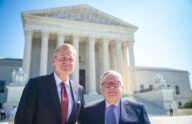PLF files reply brief in Markle
Today, Pacific Legal Foundation filed its reply brief with the Supreme Court of the United States in Markle v. U.S. Fish and Wildlife Service, an important Endangered Species Act case involving another example of federal government unconstitutional overreach. In the brief, we take on the arguments advanced by the federal government (if you are wondering why the federal government continues to pursue this case, join the club) and intervening party the Center for Biological Diversity (CBD) in their briefs in opposition.
Perhaps not surprisingly, our reply brief does not address any amicus briefs filed on behalf of the government and CBD’s position because… there were none. No one, other than the party that set this abuse of power case in motion by (CBD), and then the party that prosecuted the case (the U.S. Fish and Wildlife Service), thinks the position they articulate is defensible.
Although space prevents me from sharing all our arguments here, I want to highlight one of them because it encapsulates the weakness of the lower court decisions and the government’s position, and explains how egregious the consequences of the Fifth Circuit’s decision will be for property rights if the High Court does not reverse it:
Respondents argue, circuitously, that the Fifth Circuit decision does not bestow “virtually limitless authority” on the Service to designate “vast portions of the United States” as “critical habitat,” simply because the majority panel says it doesn’t. That is no argument. It is an assertion belied by the facts.
Subsequent to the trial court decision in Markle, the Service adopted a new rule redefining “critical habitat.” See Listing Endangered and Threatened Species and Designating Critical Habitat; Implementing Changes to the Regulations for Designating Critical Habitat. 81 Fed. Reg. 7414 (Feb. 11, 2016). In responding to public comments that the designation of non-habitat as “critical habitat” would be unlawful and contrary to the Service’s practice since 1984, the Service stated, “[t]he unoccupied areas do not have to presently contain any of the physical or biological features” essential to the conservation of the species (citing Markle Interests v. USFWS, 40 F. Supp. 3d 774 (E.D. La. 2014)). 81 Fed. Reg. 7427 (emphasis added). Contrary to Respondents’ assertion that the Fifth Circuit decision is self-limiting, the response to comments shows how the agency interprets the decision in practice—as an unbounded grant of authority to the Service to designate any area the Service believes may someday be useful for species conservation.
This new “Markle” rule was challenged by 18 states in the Southern District of Alabama and briefing in the case is stayed until March 1, 2018, pending a decision by this Court on the petition for certiorari. In another ESA case, where the Service designated “vast portions” of Utah and Colorado as “critical habitat” for the Gunnison sage-grouse, the Service recently filed a brief in opposition relying on Markle to justify the inclusion of thousands of acres of “potentially suitable” and potentially unsuitable areas as “critical habitat.” In re Gunnison Sage-Grouse, No. 1:15-cv-00130 (D. Co.). These cases provide empirical evidence that the Service is applying an extreme interpretation of the Markle decision nationwide and that the decision does in fact bestow the Service with “virtually limitless power” to subject large portions of the country to strict federal regulation. As Judge Jones opined [in her dissent], despite the panel majority’s disclaimers, “the ramifications of this decision for national land use regulation and for judicial review of agency action cannot be underestimated.”
In other words, if the Supreme Court does not put a stop to the Fish and Wildlife Service’s abuse of its authority to designate critical habitat in this case, then any property, any where, can be deemed critical habitat– for any species the federal government deems fit. That cannot be the law in a country that prizes freedom and liberty. That is why we believe the Supreme Court will grant review and, ultimately, reverse the Fifth Circuit’s decision.



